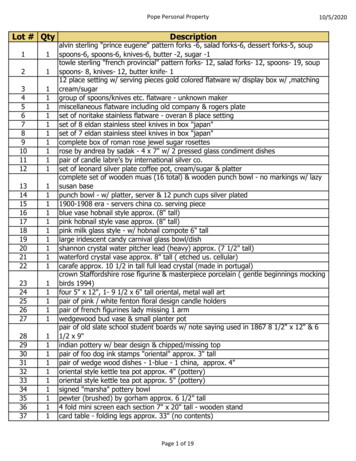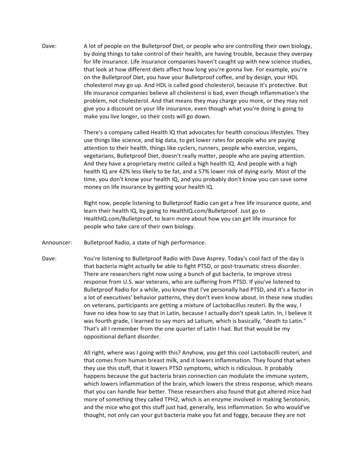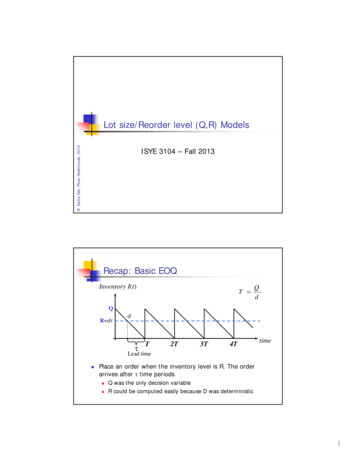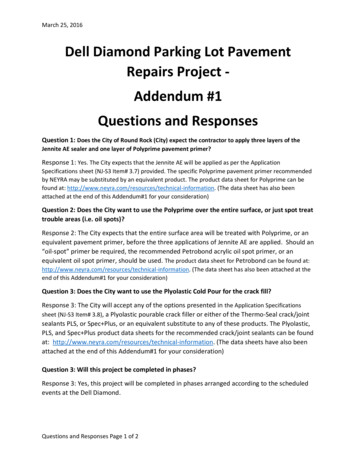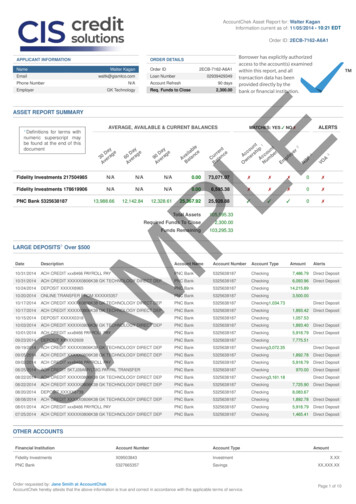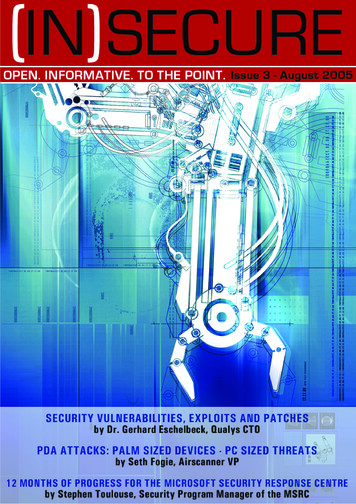
Transcription
A lot has happened in the security world in the past 2 months since the last issue of (IN)SECURE wasreleased. Itʼs always a pleasure to hear from the readers and weʼre happy to report that interest has beenvery high with many news and comments rolling in. Keep it up!This time we have some well-known authors writing on very different topics. Weʼre sure everyone will findsomething they find to be interesting. To top it all, weʼre running a book contest whose winner will be thepeople that send in the most interesting suggestions related to (IN)SECURE. Point your browser towww.insecuremag.com/contest and be creative!The editorial team:Mirko ZorzBerislav KucanVisit the magazine website at www.insecuremag.com(IN)SECURE Magazine contactsFeedback and contributions: editors@insecuremag.comAdvertising and marketing: marketing@insecuremag.comDistribution(IN)SECURE Magazine can be freely distributed in the form of the original, non modified PDF document.Distribution of substantively modified versions of (IN)SECURE Magazine content is prohibited without theexplicit permission from the editors. For reprinting information please send an email toreprint@insecuremag.com or send a fax to 1-866-420-2598.Copyright HNS Consulting Ltd. 2005.www.insecuremag.com3
Combat The Rise In Web Attacks With Acunetix Web Vulnerability Scanner 2Acunetix released Acunetix Web Vulnerability Scanner: a tool to automatically audit website security. Acunetix WVS 2 crawls an entire website,launches popular web attacks (SQL Injection, Cross Site scripting etc.) andidentifies vulnerabilities that need to be fixed.Acunetix WVS is available as an enterprise or as a consultant version. A subscription based license can bepurchased for as little as 395, whereas a perpetual license starts at 2995. For more information visitwww.acunetix.comSmoothWall Launches School GuardianSmoothWall has launched School Guardian, an integrated Internet gateway firewall andweb content filter designed specifically for educational establishments. School Guardianaddresses the three major challenges faced by school and college networks - blocking unsuitable web content, controlling access to Internet services and preventing attackersfrom compromising private systems and critical data. To learn more visitwww.smoothwall.net.Criston Releases Precision 5.2Criston, the leading European provider of systems, patch and vulnerability management announces that Criston Precision 5.2, an integrated software suitededicated to systems and security management on a company-wide scale, is nowavailable. Precision 5.2 brings a revolutionary autonomic approach to customerstation management. Based on intelligent agent technology, the solution provides users with a tool that isproven for carrying out the following applications: automatic IT assets inventory and management, largescale software distribution, remote administration, security patch management, OS deployment and migration, mobile device management, self-healing and supervision for systems, etc. More information aboutCriston and their products can be found at www.criston.comwww.insecuremag.com4
CyberGuard SG580 Appliance With Unified Threat Management FunctionalityCyberGuard Corporation announced a new all-in-one, centrally managed desktopsecurity appliance to protect small and mid-sized enterprises against externaland internal threats to their network. A robust network security solution that unifies layers of defense and response mechanisms, the CyberGuard SG580 provides Unified Threat Management functionality, including a powerful statefulinspection firewall, service-based intrusion detection blocking, Anti-Virus protection, and threat containment through Security Policy Enforcement. For more information visit www.cyberguard.com.Trend Micro Offers Three New Anti-Spyware SolutionsTrend Micro, Inc. announced three new solutions that detect and remove evasivespyware. Trend Micro Anti-Spyware represents the first significant offering resulting from the company's May 2005 acquisition of InterMute, Inc., a leading developerof anti-spyware products, and offers immediate protection against some of today'smost insidious spyware programs.New products include Trend Micro Anti-Spyware 3.0, Trend Micro Anti-Spyware Enterprise Edition 3.0 andTrend Micro Anti-Spyware for Small and Medium Businesses 3.0. In North America, the suggested retailprice for Trend Micro Anti-Spyware 3.0 is 29.95 with renewal pricing at 14.95. The price for Trend Micro Anti-Spyware for Small and Medium Businesses 3.0 ranges from 20/seat at the 5-25 user level, to 11/seat at the 501-1000 user level. For more information visit www.trendmicro.com.BeCrypt Launches Disk Protect 3.0BeCrypt, the leading UK encryption security company, has unveiled version3.0 of its DISK Protect full disk encryption security solution for laptop anddesktop computers. DISK Protect 3.0 offers features specifically tailored tothe needs of business users, including Single Sign-On, secure hibernation,removable media encryption and extended smart card support.DISK Protect is easy to install using standard network deployment tools.Once the user has entered his or her DISK Protect password and logged in to Windows, encryption istransparent. Everything written to the hard disk is automatically encrypted and everything read from thehard disk is automatically decrypted, while the user is unaware that anything extra is happening. Find outmore at www.becrypt.com.Cost Of Sarbanes-Oxley Compliance Is At The Expense Of Other SecuritySpendingA new report published by the Information SecurityForum (ISF) warns that the cost of complying with theSarbanes-Oxley legislation is diverting spending awayfrom addressing other security threats. The global notfor-profit organisation with over 260 Members including half of the Fortune 100, says that many of itsmembers expect to spend more than 10m on information security controls for Sarbanes-Oxley. Thebusiness imperative to comply also means that in many cases the true cost of compliance is unknown. Formore information about the ISF and a list of their members, visit www.securityforum.org.www.insecuremag.com5
With the growing reliance and dependence on our interconnectedworld, information security is a subject of interest to nearlyeverybody. Information security - with its focus on confidentiality,integrity and availability - is frequently undermined by securityvulnerabilities.One of the most drastic demonstrations ofor even users being tricked into opening asecurity vulnerabilities and exploits wasmalicious email. All these vulnerabilitiesshown during a recently conducted ex-have one issue in common ‒ they causeperiment “Time to Live on theNetwork”1.During this test, default-installed, and notsecurity exposure to an individual system,or even a whole organization.fully patched systems were connected tothe Internet and were monitored for activ-The most prevalent and widely exploitedity. Not surprisingly, within a few minutessecurity vulnerabilities are caused by pro-the first system came under attack andgramming flaws in various software prod-was completely compromised a few min-ucts and applications. Typical examples ofutes later. Security vulnerabilities and ex-such programming flaws are so calledploits are a real world issue requiring fo-buffer overflows in computer programs.cus and attention for enterprises as wellBuffer overflows trigger accidental over-as home users.writing of sections of memory, which canbe compared with people filling out hand-Security Vulnerabilities ‒ Thepath to security breacheswritten forms, which provide one spacefor each character of a personʼs name. Ifthere are not enough spaces for a per-Security vulnerabilities linger and consequently create a breeding ground for exploits, leading to security breaches. Security vulnerabilities originate from manydifferent areas - incorrectly configuredsystems, unchanged default passwords,sonʼs name you have the equivalent of abuffer overflow in a computer program.The result of a buffer overflow couldcrash the affected program, or even allowan attacker to execute arbitrary code, andtherefore take over the system.product flaws, missing security patches,1“Time to Live on the Network”, Avantgarde, 6
The security research community as wellinformation or for financial benefit. Fur-as vendors identify and publish on aver-thermore, exploits are published widelyage 40 new security vulnerabilities perand serve as building blocks for wormsweek in various products, from operatingand automated attacks. Such malicioussystems, databases, applications to evenprograms replicate and circulate auto-networking devices. Upon release of newmatically on networks identifying un-vulnerabilities they are being assignedpatched systems. One of the first exam-unique CVE (Common Vulnerabilities andples of such automated attacks was theExposures) identifiers 2 to uniquely distin-Morris worm in 1988 3, followed by manyguish and reference them throughoutmore recent examples such as Slammer,their life-cycle. Depending on the severityBlaster, Sasser, and other worms. Depend-of an individual security vulnerability, iting on the specific payload worms are car-allows an attacker to bring down, accessrying, in some cases the victims may beconfidential data, or take control of a vul-able to recover from the attack, butnerable system. The software develop-mostly it is necessary to fully rebuild com-ment community is responding with proac-promised systems to ensure system integ-tive steps. Improved software develop-rity.ment processes as well as continuouseducation of software engineers is one ofthe steps taken to enhance product security. Focused testing for security flawshelps to prevent and to identify such flawsbefore products are released to the market.Exploits and AttacksA critical factor for the impact of an exploit is the timing ‒ how quickly the exploitcode is created and available for a specificvulnerability. Recent automated attacksshrank the time-to-exploit window frommonths to days and happened faster thanany possible human response. Rapid availability of exploits creates significant windows of exposure for organizations untilthey remedy their critical systems. SQLExploits are specifically crafted maliciousSlammer happened six months after dis-programs which take advantage of secu-covery, Nimda was four months, Slapperrity vulnerabilities and their systems.was six weeks, Blaster came just threeBrowsing the web, reading email, or justweeks after news of the vulnerability, andbeing connected to the Internet can leadthe Witty worm struck the day after an-to exploitation of security vulnerabilities.nouncement of the vulnerability.Exploit programs are utilized by individualattackers to target and take over an indi-2vidual system ‒ mostly with a specific mo-The diagram below illustrates compressiontive in mind, such as access to confidentialof the discovery/attack life-cycle.“Common Vulnerabilities and Exposures”, MITRE Corporation, cve.mitre.orgwww.insecuremag.com7
The most forceful scenario was the Wittystructive payload; spread in an organizedworm, which on March 19, 2004 struckmanner with more ground-zero hosts; hadabout 12,000 computers running firewallsshortest interval between vulnerabilityfrom Internet Security Systems. Wittydisclosure and worm release (one day);reached its peak after about 45 minutes.attacked only hosts running security soft-At that time it had infected most of theware; and proved that applications in avulnerable hosts. According to an analysisniche market are as vulnerable as thoseby CAIDA and UCSD3,Witty earned sev-from a software monopoly.eral exploitation “firsts”: widespread, de-Security Patches ‒ Protectingfrom ExploitsThe timely installation of security patchesor other workarounds to every vulnerablesystem is a necessary defense mechanismto prevent exploits from attacking andcompromising the system. In a perfectworld a vendor provides security patchesat the time of the release of a vulnerability, providing users the ability to protecttheir systems from exploits. Unfortunately, this is not always the case, andsometimes a vulnerability becomes knownbefore remedies are available. In some instances, even exploits had been circulatingbefore patches were available. These socalled zero-day exploits pose a significantdanger putting users at risk from exploitation. Applying security patches is not theonly solution to the problem. Workaroundsexist to mitigate risk and prevent exploita-3tion. Intrusion prevention technologies andother filtering capabilities help to preventattacks without the immediate need of installing patches.One of the key issues for every organization is to identify the perfect timing forpatching vulnerable production systems.Sometimes patching requires downtimeand is disruptive. On the other side lingering exploits require urgent attention. Patchstrategies within organizations have matured significantly over the past two years,and organizations are building metrics tomeasure the severity and criticality of vulnerabilities to determine their urgency.Also, the implementation of predictablepatch release schedules (i.e. monthly,weekly) from various vendors helps toeliminate the patch-of-the-day syndromemany organizations were struggling with inthe past.See “The Spread of the Witty Worm,” Cooperative Association for Internet Data Analysis and University of California atSan Diego, ag.com8
The Vulnerability ManagementProcessSuccessful defenses against network vulnerabilities require utmost understandingthe nature of the risk they pose. Vulnerability Management involves the processof identification, prioritization, and remediation of security vulnerabilities. Following the principle of “You can't managewhat you can't measure“, many enterprises have successfully implemented asystematic vulnerability managementprocess involving the following six steps:1) Discovery: Identification and discoveryfollowing questions should guide the process. Is the vulnerability exploitable fromany system on the network, or does it depend on a user account on the target? Hasexploit code already been released? Whatbusiness resources are affected by thevulnerability? Those factors are unique forevery circumstance and determine thethreat level of a vulnerability within a specific environment. Vulnerability benchmarks, such as the SANS/FBI Top 20 4 arefrequently adopted to measure specificvulnerability exposure of an environment.The Business Side of Vulnerabilities and Exploitsof devices, systems, and network topologyto keep track of constantly changing net-Vulnerabilities have a measurable impactworks.on organizations of any size. When critical2) Asset Prioritization: Assigning businesssystems are unavailable and data is notvalues and priorities to individual systemsaccessible due to an attack, organizationsand applications. Network security teamsare loosing valuable business. Many en-should correspondingly prioritize their re-terprises implement vulnerability man-mediation efforts based on asset valueagement as a proactive process closelyand criticality to an organization.linked into a broader risk management3) Assessment & Analysis: Comprehensivestrategy. Business owners within an or-analysis of systems as well as identifyingganization need to be involved to establishcriticality and severity of security vulner-the required support. Information aboutabilities and security exposure. This in-security exposure is reported to the ex-formation helps to determine what busi-ecutive level and in some organizationsness resources are at risk and what needseven board level on an ongoing basis. Inattention first.particular, tracking vulnerability informa-4) Remediation: Eliminating identified se-tion over time is a very valuable tool tocurity vulnerabilities by reconfiguring, up-justify security investment and to proofdating or patching systems. Sometimesthe return of investment. Other drivingworkarounds can be applied as a tempo-forces for implementing a consistent vul-rary solution.nerability management process are regu-5) Verification: Validation of patches andlatory requirements. In particular, indus-workarounds to confirm proper remedia-tries where confidentiality and integrity oftion.information (such as financial, health care,6) Policy Compliance: Measuring and re-or other critical sectors) are most criticalporting against security policies and com-requirements, organizations perform regu-pliance requirements, such as HIPAA, Sar-lar vulnerability audits to verify and reportbanes Oxley, as well as industry specificregulatory compliance. Also, the popularregulations.trend of outsourcing IT systems and operations drives the implementation of se-Driven by an organizationʼs security policy,curity service level agreements, wherebythe vulnerability management processthe outsourcing provider has to conformshould be implemented as a global effortto specifically defined metrics in terms ofwithin an enterprise. The level of threat apatching security vulnerabilities. Vulner-vulnerability poses to an organizationability management processes and secu-should determine the level of action. Therity audits are a vital part to measure andenforce such service level agreements.4“The Twenty Most Critical Internet Security Vulnerabilities”, www.sans.org/top20www.insecuremag.com9
Actions to be Takenthreats and remedies is a crucial successfactor.In summary, security attacks on networksand data are increasing in number and Regular Audits of Security Systems.New automated audit solutions discoversophistication. A new generation of auto-everything susceptible to attack, identify,mated security threats is exploiting vul-and prioritize vulnerabilities, and providenerabilities faster than any possible hu-appropriate remedies.man response effort. The timely and complete detection of security vulnerabilitiesand rapid application of remedies is themost effective preventive measure network managers can use to thwart automated attacks and preserve data security. Timely Patch Management. This criticalprocess frequently requires manual support with automated solutions to remedysystems in need of urgent care. Implementation of Real-Time ThreatPrevention. Firewalls and intrusion preBest practices can guide vulnerabilityvention systems can help stop attacks be-management and remediation, helpingfore penetration.CIOs, chief security officers, network and IT managers, and security specialists tostrengthen and prioritize the protection ofinternal and external networks. Protectionstrategies include: Ongoing Evaluation of Security Policy.Trend analysis provides data for enforcingpolicy and ensures that security systemsmeet the ever-changing nature of attackthreats.Education and Awareness. Providingusers with actionable information aboutGerhard Eschelbeck is chief technology officer and vice president of engineering for Qualys, Inc. Hepublished the industry's first research derived from a statistical analysis of millions of critical vulnerabilities over a multi-year period. Eschelbeck presented his findings before Congress, and is a significant contributor to the SANS Top 20 expert consensus identifying the most critical security vulnerabilities. He holds several patents in the field of managed network security and earned Masters andPh.D. degrees in computer science from the University of Linz, Austria. Eschelbeck can be reached atge@qualys.com.www.insecuremag.com10
The Tao of Network Security Monitoring: Beyond Intrusion Detectionby Richard BejtlichAddison-Wesley Professional, ISBN: 0321246772By combining a couple of facts about Richard Bejtlich, such as being one ofthe the biggest names in the information security community and being anavid reviewer of technical books at Amazon (currently over 180 reviewsposted), you can be certain that his bo
Criston, the leading European provider of systems, patch and vulnerability man-agement announces that Criston Precision 5.2, an integrated software suite dedicated to systems and security management on a company-wide scale, is now available. Precision 5.2 brings a revolutionary autonomic approach to customer station management.




